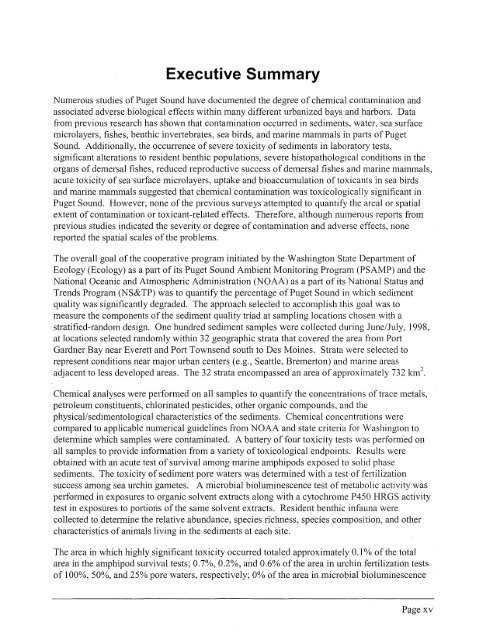Sediment Quality in Puget Sound Year 2 - Center for Coastal ...
Sediment Quality in Puget Sound Year 2 - Center for Coastal ...
Sediment Quality in Puget Sound Year 2 - Center for Coastal ...
Create successful ePaper yourself
Turn your PDF publications into a flip-book with our unique Google optimized e-Paper software.
Executive Summary<br />
Numerous studies of <strong>Puget</strong> <strong>Sound</strong> have documented the degree of chemical contam<strong>in</strong>ation and<br />
associated adverse biological effects with<strong>in</strong> many different urbanized bays and harbors. Data<br />
from previous research has shown that contam<strong>in</strong>ation occurred <strong>in</strong> sediments, water, sea surface<br />
microlayers, fishes, benthic <strong>in</strong>vertebrates, sea birds, and mar<strong>in</strong>e mammals <strong>in</strong> parts of <strong>Puget</strong><br />
<strong>Sound</strong>. Additionally, the occurrence of severe toxicity of sediments <strong>in</strong> laboratory tests,<br />
significant alterations to resident benthic populations, severe histopathological conditions <strong>in</strong> the<br />
organs of demersal fishes, reduced reproductive success of demersal fishes and mar<strong>in</strong>e mammals,<br />
acute toxicity of sea surface microlayers, uptake and bioaccumulation of toxicants <strong>in</strong> sea birds<br />
and mar<strong>in</strong>e mammals suggested that chemical contam<strong>in</strong>ation was toxicologically significant <strong>in</strong><br />
<strong>Puget</strong> <strong>Sound</strong>. However, none of the previous surveys attempted to quantify the areal or spatial<br />
extent of contam<strong>in</strong>ation or toxicant-related effects. There<strong>for</strong>e, although numerous reports from<br />
previous studies <strong>in</strong>dicated the severity or degree of contam<strong>in</strong>ation and adverse effects, none<br />
reported the spatial scales of the problems.<br />
The overall goal of the cooperative program <strong>in</strong>itiated by the Wash<strong>in</strong>gton State Department of<br />
Ecology (Ecology) as a part of its <strong>Puget</strong> <strong>Sound</strong> Ambient Monitor<strong>in</strong>g Program (PSAMP) and the<br />
National Oceanic and Atmospheric Adm<strong>in</strong>istration (NOAA) as a part of its National Status and<br />
Trends Program (NS&TP) was to quantify the percentage of <strong>Puget</strong> <strong>Sound</strong> <strong>in</strong> which sediment<br />
quality was significantly degraded. The approach selected to accomplish this goal was to<br />
measure the components of the sediment quality triad at sampl<strong>in</strong>g locations chosen with a<br />
stratified-random design. One hundred sediment samples were collected dur<strong>in</strong>g JuneIJuly, 1998,<br />
at locations selected randomly with<strong>in</strong> 32 geographic strata that covered the area from Port<br />
Gardner Bay near Everett and Port Townsend south to Des Mo<strong>in</strong>es. Strata were selected to<br />
represent conditions near major urban centers (e.g., Seattle, Bremerton) and mar<strong>in</strong>e areas<br />
adjacent to less developed areas. The 32 strata encompassed an area of approximately 732 km!<br />
Chemical analyses were per<strong>for</strong>med on all samples to quantify the concentrations of trace metals,<br />
petroleum constituents, chlor<strong>in</strong>ated pesticides, other organic compounds, and the<br />
physical/sedimentological characteristics of the sediments. Chemical concentrations were<br />
compared to applicable numerical guidel<strong>in</strong>es from NOAA and state criteria <strong>for</strong> Wash<strong>in</strong>gton to<br />
determ<strong>in</strong>e which samples were contam<strong>in</strong>ated. A battery of four toxicity tests was per<strong>for</strong>med on<br />
all samples to provide <strong>in</strong><strong>for</strong>mation from a variety of toxicological endpo<strong>in</strong>ts. Results were<br />
obta<strong>in</strong>ed with an acute test of survival among mar<strong>in</strong>e amphipods exposed to solid phase<br />
sediments. The toxicity of sediment pore waters was determ<strong>in</strong>ed with a test of fertilization<br />
success among sea urch<strong>in</strong> gametes. A microbial biolum<strong>in</strong>escence test of metabolic activity was<br />
per<strong>for</strong>med <strong>in</strong> exposures to organic solvent extracts along with a cytochrome P450 HRGS activity<br />
test <strong>in</strong> exposures to portions of the same solvent extracts. Resident benthic <strong>in</strong>fauna were<br />
collected to determ<strong>in</strong>e the relative abundance, species richness, species composition, and other<br />
characteristics of animals liv<strong>in</strong>g <strong>in</strong> the sediments at each site.<br />
The area <strong>in</strong> which highly significant toxicity occurred totaled approximately 0.1 % of the total<br />
area <strong>in</strong> the amphipod survival tests; 0.7%, 0.2%, and 0.6% of the area <strong>in</strong> urch<strong>in</strong> fertilization tests<br />
of loo%, 50%, and 25% pore waters, respectively; 0% of the area <strong>in</strong> microbial biolum<strong>in</strong>escence<br />
Page xv







